Pearls are one of a kind; rare, beautiful, and the only gemstone produced from a living creature! No wonder humans have sought them out for thousands of years. Thousands of years ago, the ancient Indus Valley civilization collected and wore pearls in their jewelry. Later, precious pearls were placed in the tombs of Egyptian pharaohs and were even mentioned in sacred religious texts like the Bible. For the ancient Greeks, pearls were highly valued by the gods and were only worn by powerful and wealthy people. Even in ancient Rome, Julius Caesar passed a law so that only the upper classes could wear pearls!

Today we live in a modern world where technology allows us to find and cultivate pearls much more easily than in centuries past, and still, we value them for their beauty and rarity. Although we often imagine pearls as simple and white, they actually come in many different colors — both through human intervention and out in nature. Dive in and check out the many different colors of pearls, ranging from the rarest to the most common!
How Do Pearls Get Their Color?
When a tiny piece of sand or small irritant accidentally finds its way into a mollusk’s shell, the creature doesn’t like it. So, to protect itself, the mollusk starts secreting nacre, or mother of pearl. Nacre is like a secret layer of the mollusk’s shell, made of crystalline aragonite (a type of calcium carbonate) and a protein called conchiolin. To make the grain of sand less irritating, the mollusk continually covers it over and over again with layers of this colorful and shiny material — and eventually, these layers form a beautiful pearl!
All pearls pass through this process, with the nacre slowly providing them each their own unique color. The color of each pearl depends on several elements, such as the type of oyster, its location, the quality of the nacre, and the environment and growing conditions.
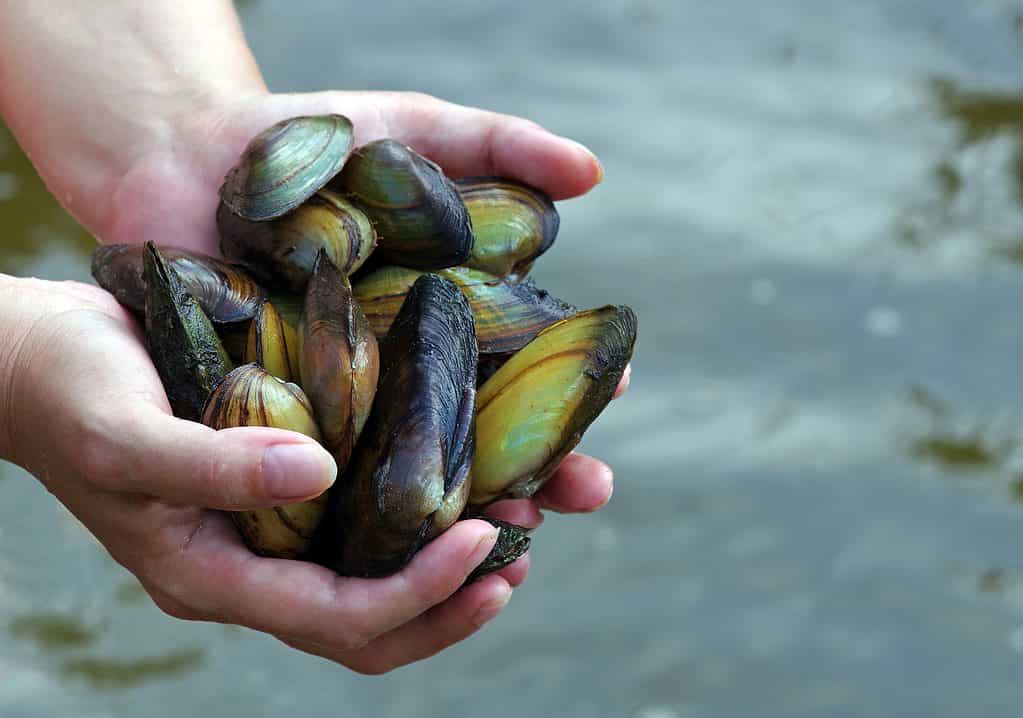
Not every mollusk produces pearls — in fact, out of every ten thousand oysters, only
onewill produce a pearl of its own!
©KRIACHKO OLEKSII/Shutterstock.com
Natural pearls, as the name suggests, are formed naturally without any help from humans, born purely by mollusks in the ocean. Sometimes, lucky explorers searching for oysters and other mollusks stumble upon these rare and precious natural pearls by chance.
Cultured pearls, on the other hand, still come from mollusks, but through a slightly different course of events. Skilled farmers encourage the mollusks to create pearls specifically for harvesting and help care for them from the beginning all the way to the end product.
Although many people dye them, both natural and cultivated pearls also come in a wide variety of dazzling colors all on their own. Let’s take a closer look at the many colors of pearls, from the rarest to the most common!
1. Blue Pearls
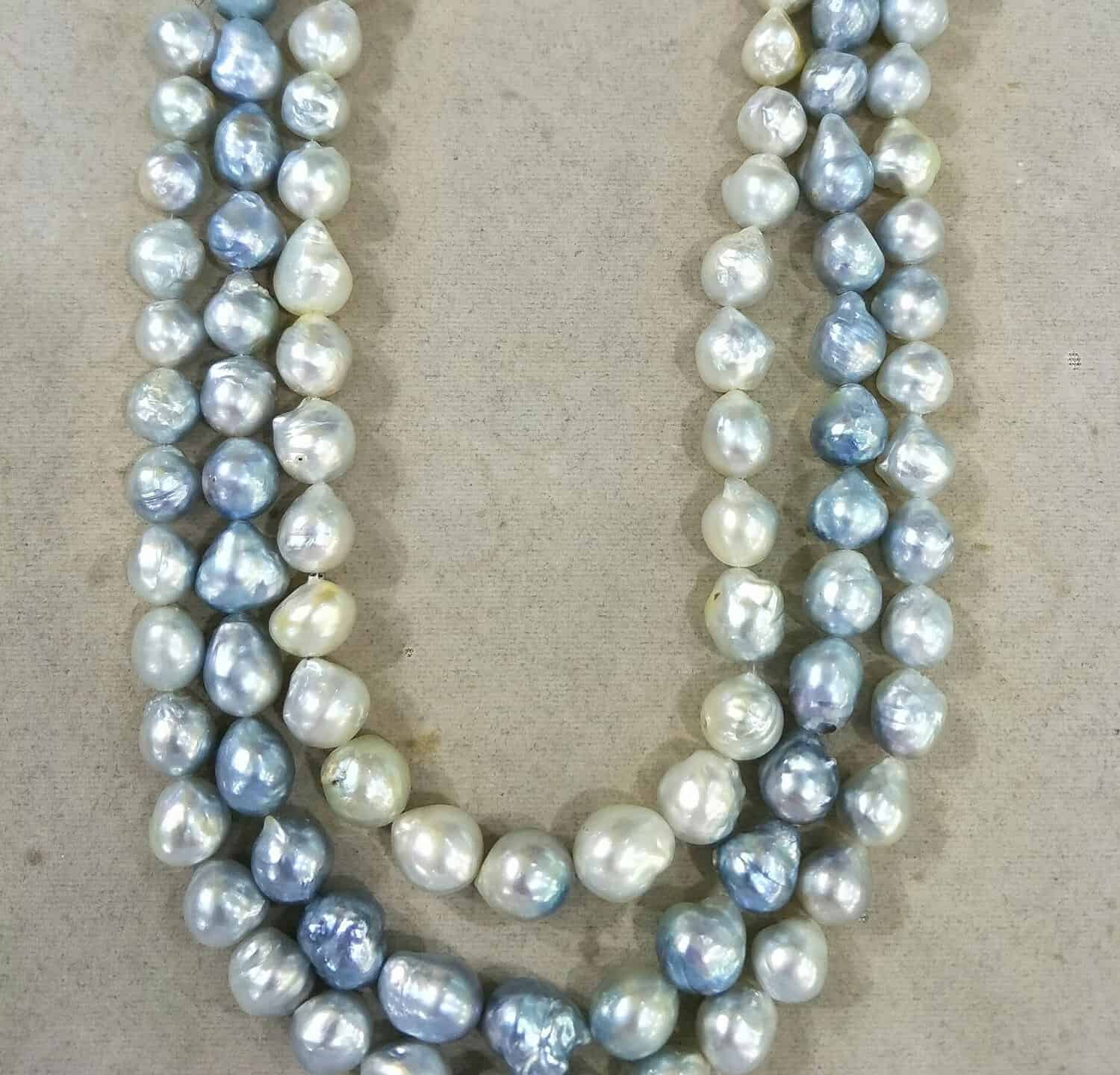
Perfectly round blue pearls are
extremelyrare.
©Areeka/Shutterstock.com
The rarest natural pearl color is blue, and it is extremely hard to come by. Blue pearls range from a pretty pastel blue to light aquamarine or a deep, dark blue. Blue pearls are also unique because they’re not usually round, and they rarely have a perfect shape. Most blue pearls have bumpy or irregular shapes with a touch of wildness to them, and they tend to be smaller than other types of pearls.
Because of their “imperfect” shapes, blue pearls weren’t very valuable until quite recently. In fact, back in the day, if you found a blue pearl, you simply threw it out. And yet, today their rarity and unique style makes them some of the most valuable pearls in the ocean!
Most blue pearls come from the oceans around Australia and Japan. They average from 6 mm to 14 mm (0.24 inches to 0.55 inches). However, the size often depends on the type of pearl and where it comes from. For example, blue Akoya pearls from China, Korea, and Japan are the most common type of blue pearls. They typically measure between 7.5 mm and 9.5 mm (0.3 inches to 0.37 inches). On the other hand, blue Tahitian pearls are found in French Polynesia and range from 8 mm to 14 mm (0.32 to 0.55 inches). Then there are the silver-blue South Sea pearls from Australia and Indonesia, which can range from 9 mm (0.354 inches) all the way up to 16 mm (0.63 inches)!
2. Golden Pearls
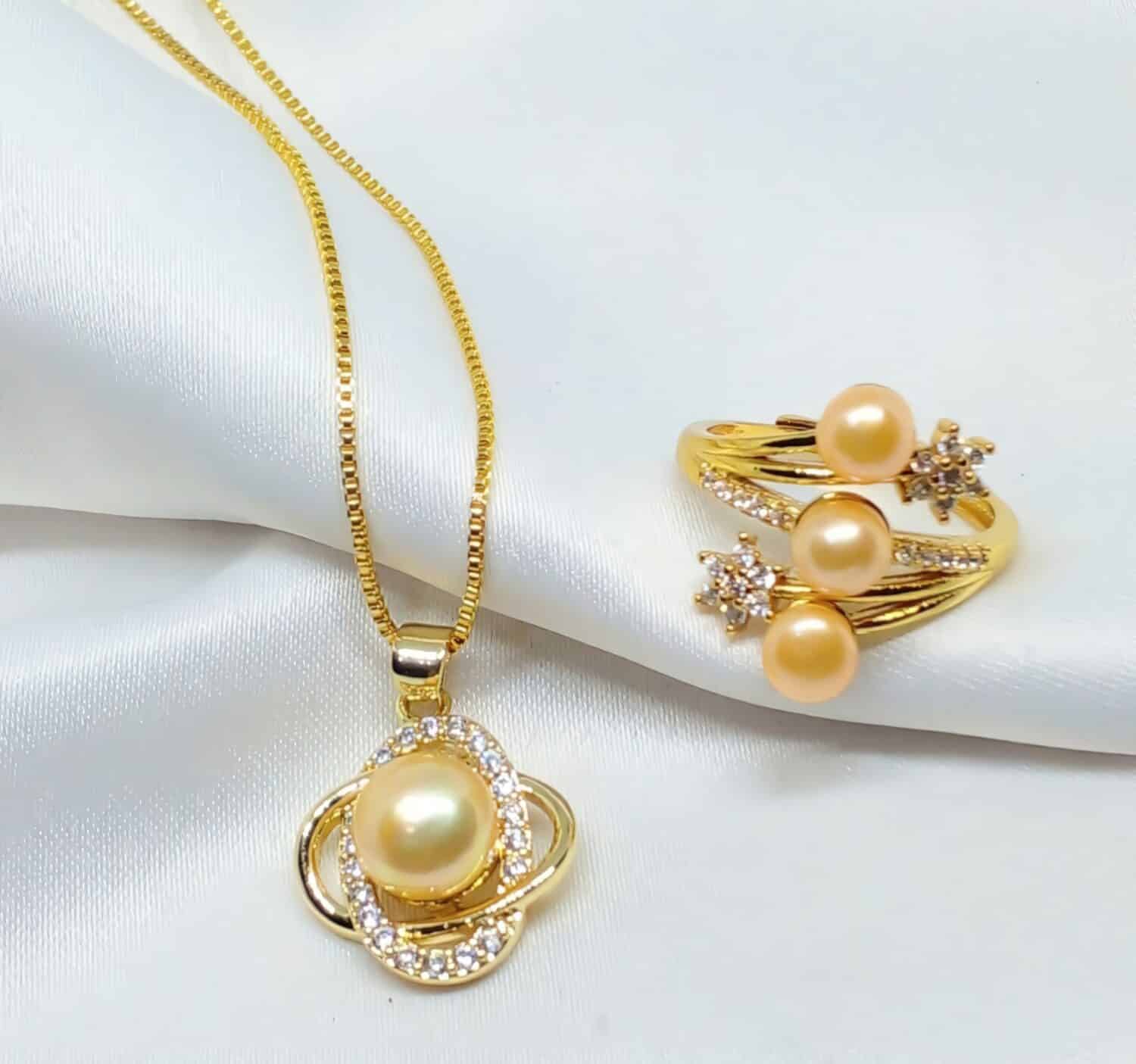
Gold pearls come from gold-lipped pearl oysters (
Pinctada maxima). These oysters can grow up to 12 inches in diameter, allowing them to produce fairly large, golden pearls.
©ikhwan al haqim/Shutterstock.com
Although blue pearls are the rarest color you will find, many of the most expensive pearls are golden. Found in the waters of Indonesia, the Philippines, and Australia, golden pearls are usually round or baroque (irregular), with an especially bright and shiny exterior. Golden pearls also tend to be on the larger end, ranging from 6 mm to 20 mm (0.24 inches to 0.79 inches), which also adds to their value.
The best part of golden pearls is that their brilliant warm colors are completely natural! The gorgeous golden color comes from a special and very rare pigment that naturally occurs in the shell of a gold-lip Pinctada maxima oyster. Golden pearls range in many beautiful golden hues, from pale yellow to deep rich gold. However, golden South Sea pearls can take two to four years to fully develop, which is another reason they are some of the highest-valued pearls out there.
3. Lavender and Purple Pearls
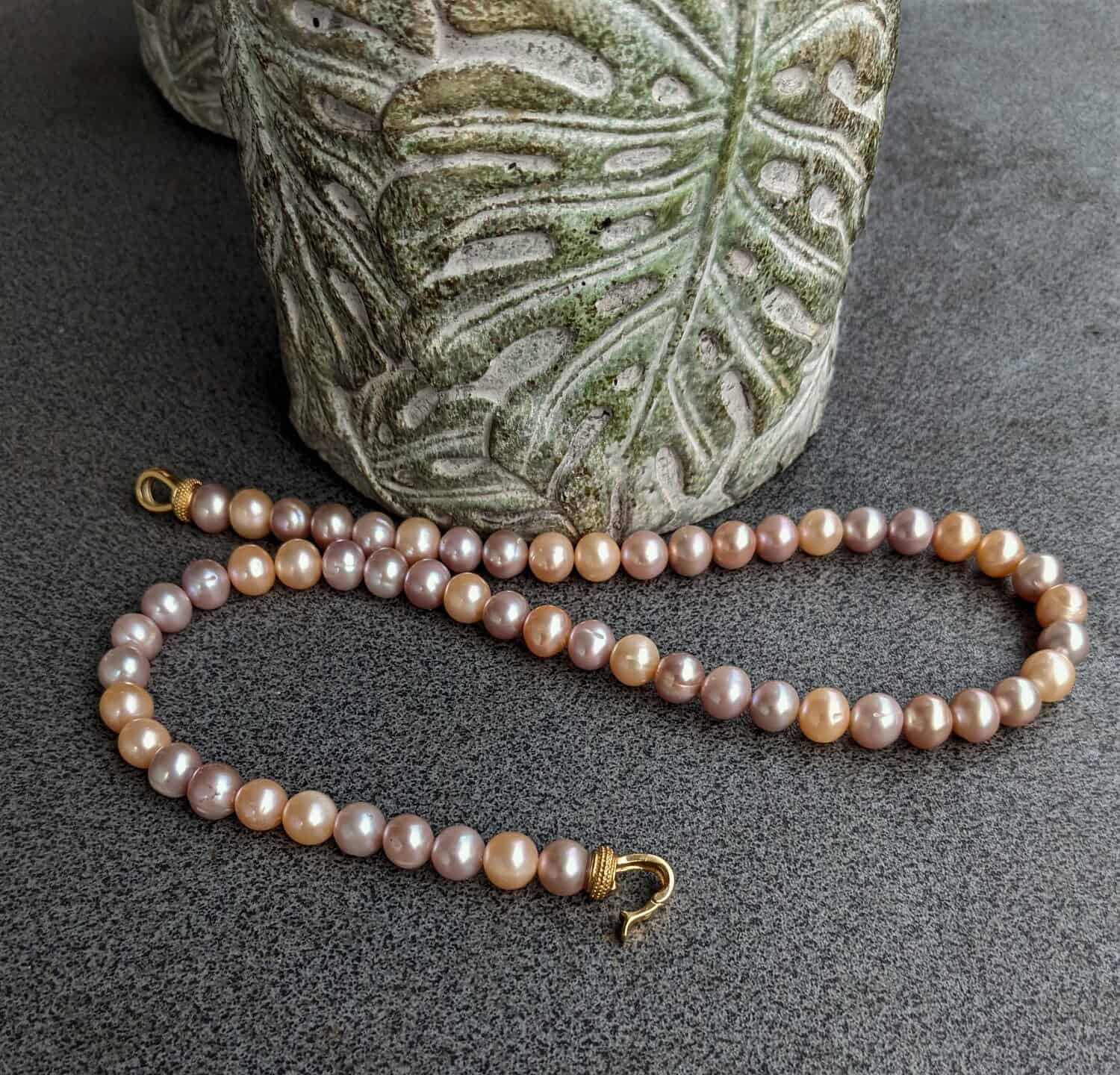
Many believe that lavender pearls have calming and relaxing properties and can help reduce stress or anxiety.
©LaCatella/Shutterstock.com
Purple and lavender pearls come in many elegant hues, from pastel lilac to deep violet and even royal purple. Lighter, lavender pearls typically range in size from 1 mm up to 10 mm (0.04 inches to 0.39 inches). They have a light purple core and often feature natural overtones of blue-green, green, rose, gold, or silver. Many lavender pearls come from Tahiti or the South Sea and have an opalescent appearance.
There are also aubergine purple pearls, which are typically dark purple Tahitian pearls with greenish or reddish overtones. In addition, the “Edison” freshwater pearl is dark purple and typically much larger, ranging from 13 mm up to 17 mm (0.51 inches to 0.67 inches). Both aubergine purple and Edison pearls are very popular. However, since they are rare, they are very expensive, and you may see many that have been color-treated to achieve the desired purple hue.
4. Cherry Pearls

Tahitian pearls come in an endless array of colors. Each pearl has its own unique combination of core color, undertones, and overtones.
©MPH Photos/Shutterstock.com
While there are no truly natural or cultivated red pearls (if you ever see a red pearl, it’s either artificial or has been color-treated and dyed), there are some incredible Tahitian pearls that have rare but beautiful reddish tones. Referred to as cherry pearls, these glamorous Tahitian pearls are a reddish pink color, with a reddish pink shimmering overtone. Some might also have a splash of green or peacock mixed in with their cherry vibes However, the really cherry red pearls are extremely rare and look like shining rosy-colored copper pennies.
5. Green Pearls
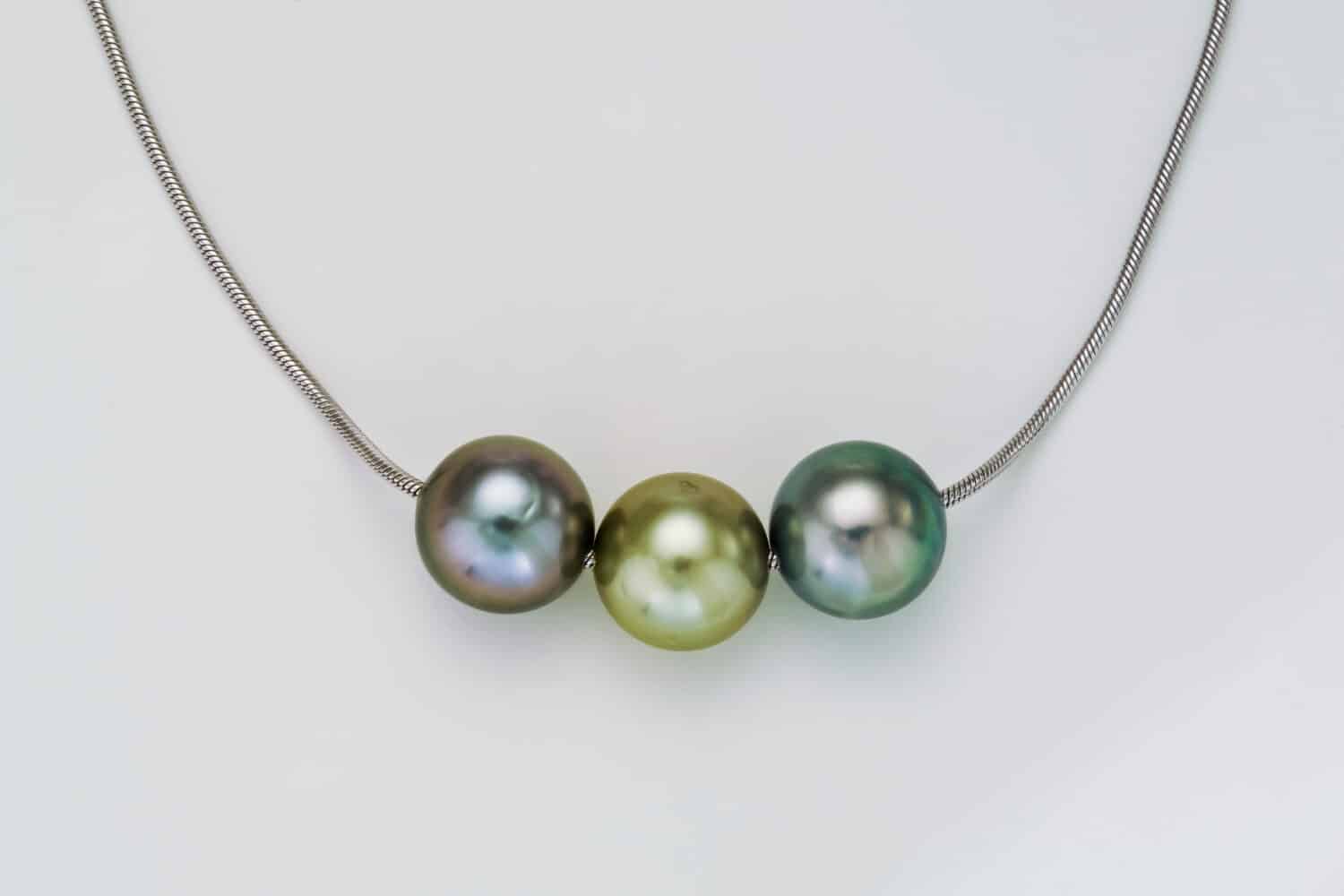
Many green pearls, such as peacock pearls, are produced by black-lipped pearl oysters (
Pinctada margaritifera).
©Van Rossen/Shutterstock.com
Yes, believe it or not, there really are naturally green pearls out there! However, they are extremely hard to find and they cost a lot. So, most of the green pearls you see in the market today are actually dyed to look that way.
Natural green pearls, on the other hand, are extremely rare, found in both salty ocean water and fresh river water oysters. But the ones that really steal the show are the illustrious Tahitian pearls. These emerald beauties are grown in French Polynesia and come in all different shades of green, from light and delicate to dark and mysterious. Some of them also have a hint of blue or purple in their coloring as well.
Peacock Tahitian pearls are especially popular, due to their rich, peacock-green coloring and incredibly bright luster. These pearls have a reddish or copper-red core, surrounded by a vibrant green halo. There are also pistachio Tahitian pearls, which are a natural silver-green or mint-green color. They range from light to dark and typically have a very subtle gold, silver, or rose overtone.
6. Chocolate and Brown Pearls
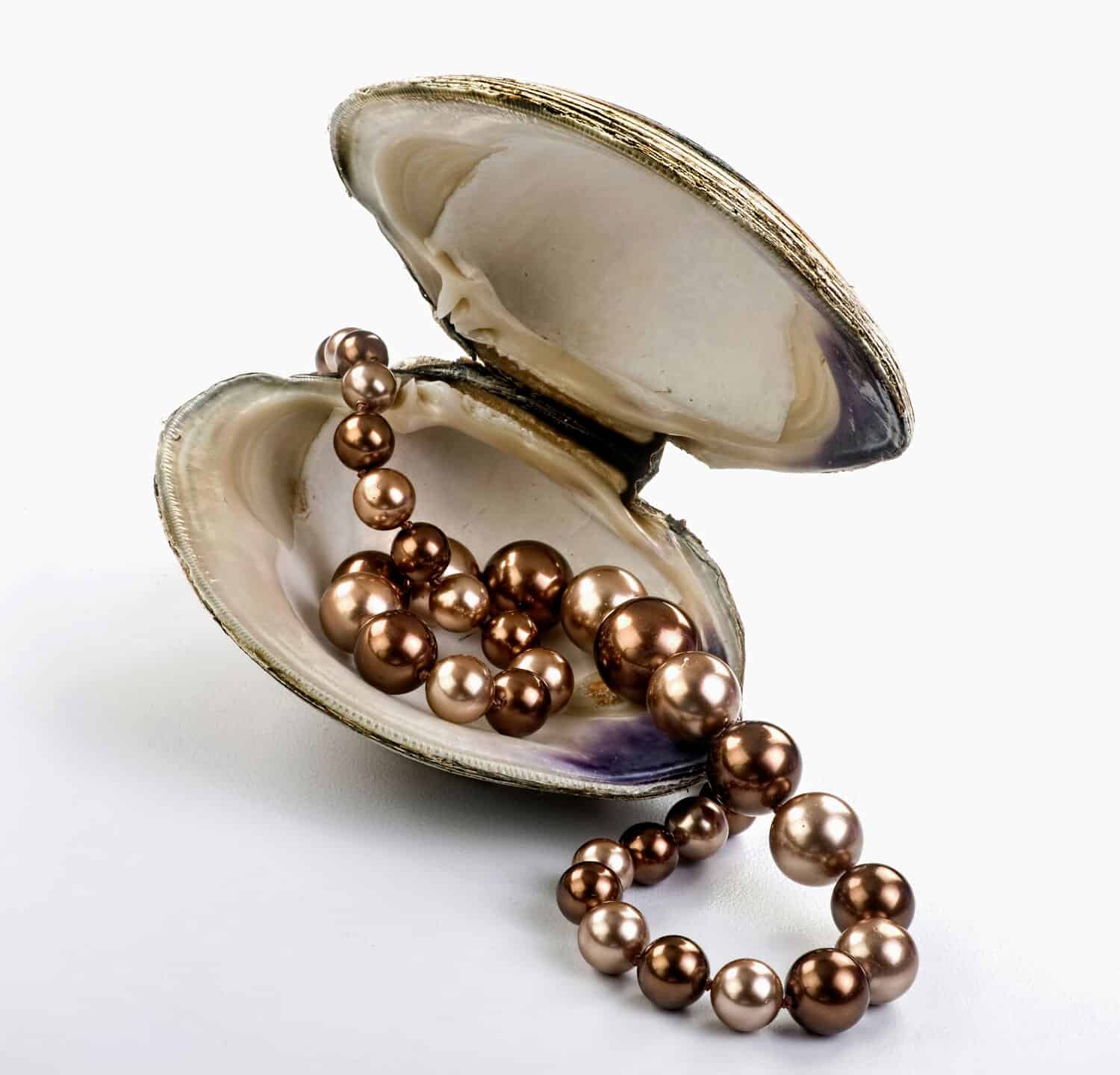
Chocolate pearls are very popular in the fashion world today.
©W. Scott McGill/Shutterstock.com
Found in both freshwater and saltwater, brown and chocolate pearls range from the lightest honey tones to the deepest and darkest chocolate hues. Chocolate pearls hit the fashion scene in the late 1990s. Ever since, they have only continued to grow in popularity, so you’ll also find dyed brown pearls alongside natural ones. Natural Tahitian chocolate pearls are usually rich bronze, charcoal brown, chocolate, mink, or greenish brown. They have overtones of bronze, rose, green, and gold, with a highly shiny luster that makes them look almost metallic. Dyed pearls or color-treated pearls, on the other hand, tend to have more solid chocolatey colors.
7. Pink Pearls
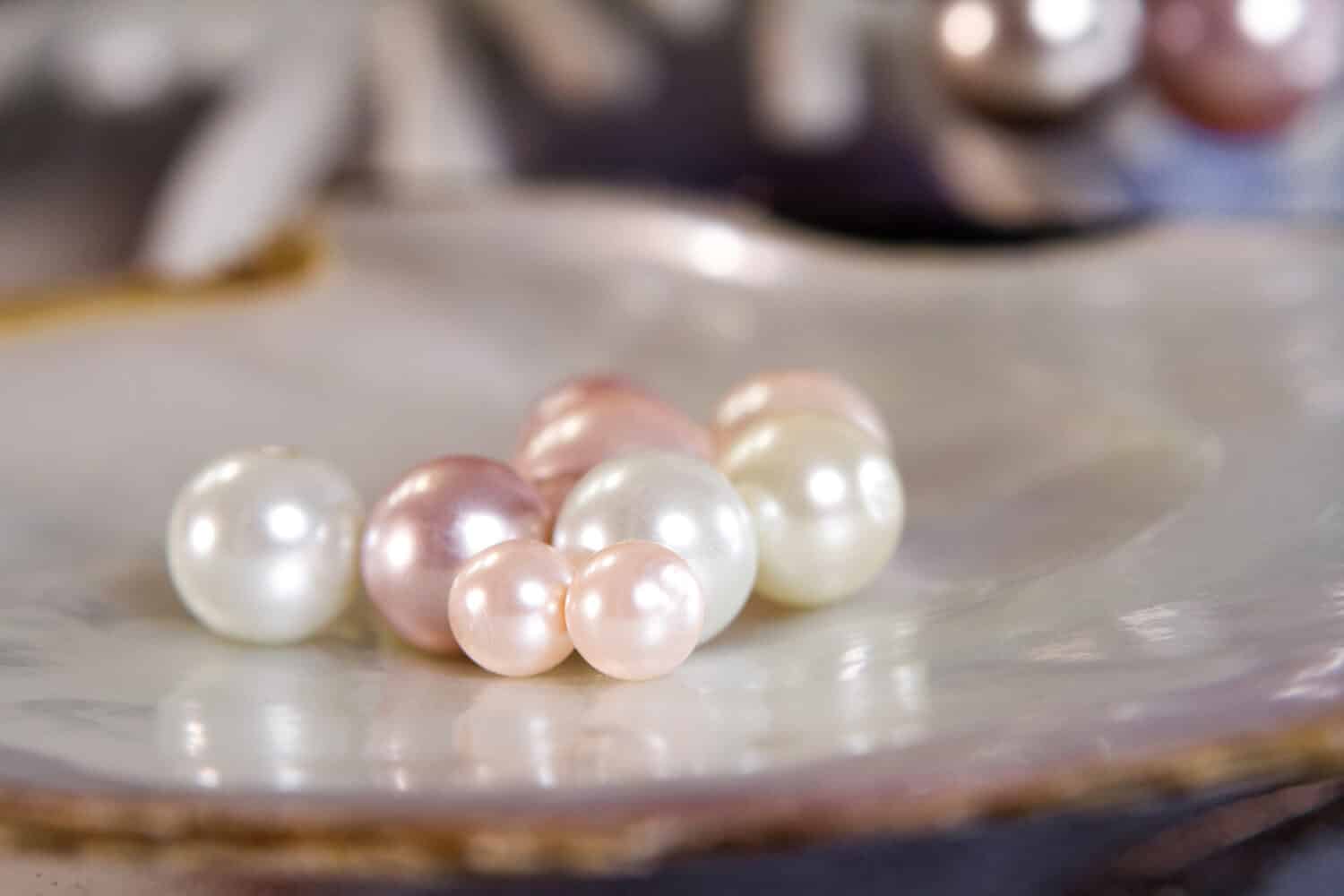
Many pink pearls, like Akoya and South Sea pearls, are naturally pink. However, freshwater pearls are also commonly dyed pink due to the high demand for this color.
©Praiwan Wasanruk/Shutterstock.com
Another rare color of pearl is pink, with freshwater pink pearls more common. Most of them come from China, although they can also be found in Japan and the United States as well. In fact, the largest pink pearl on record was found in California’s Salt Point State Park. Wesley Rankin found the “Big Pink Pearl” in 1990, which was valued at $4.7 million in 1991! Scientists believe it was produced by either a pink abalone (Haliotis corrugata) or a red abalone (Haliotis rufescens).
Pink pearls range from soft pastel pink to a rich deep rose color. Some can also have a slightly peachy or lavender tint as well. They can range from 2 mm to 15 mm (0.08 inches to 0.59 inches) but are generally 6 mm to 10 mm (0.24 inches to 0.39 inches). There are also pink pearls that have been dyed by professionals, giving them a rosy-colored sheen. In fact, pink is becoming one of the more popular colors of pearl jewelry, and in many markets, it is almost as popular as classic white pearls!
8. Black Pearls
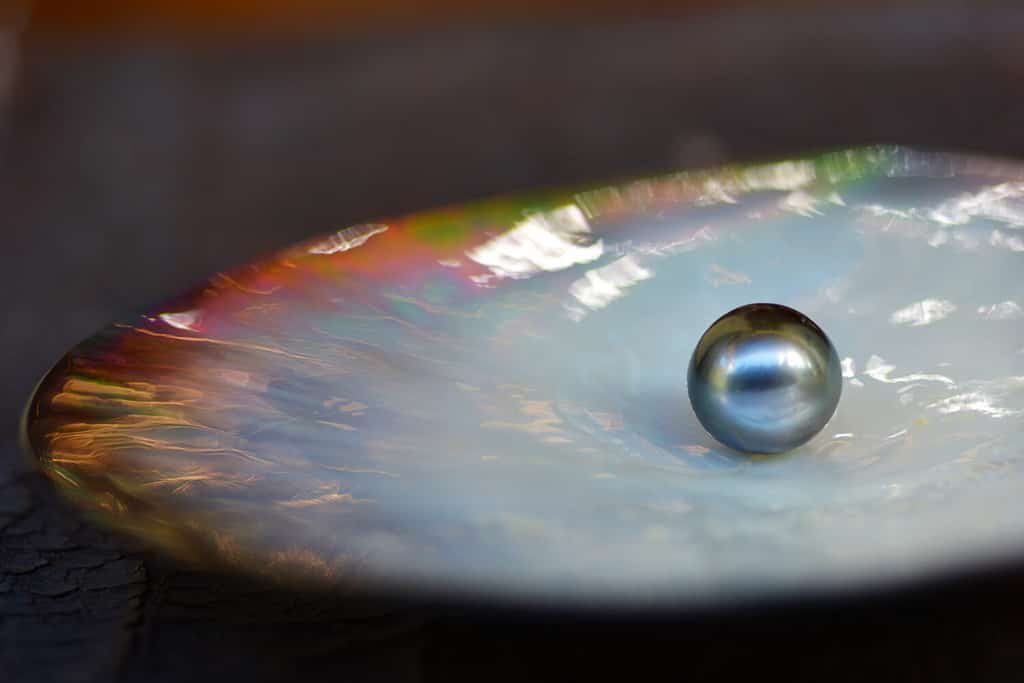
Black pearls were quite rare and expensive for many centuries, but with modern pearl farming, they are much easier to obtain. However, they are still uncommon and can cost quite a bit.
©ChameleonsEye/Shutterstock.com
No, we’re not Jack Sparrow’s pirate ship — these are actual, real black pearls. The most common you’ll see are black Akoya pearls. However, they aren’t really black, or at least not naturally! Although still beautiful, black Akoya pearls are treated to give them their dark coloring. But, if you want a pearl that’s naturally black, then you’ve got two great options: Tahitian pearls and Cortez pearls.
Produced off the coasts of French Polynesia, black Tahitian pearls are actually very rarely all-black. Instead, they range from dark gray to charcoal, silver, and yes, on extremely rare occasions, fully black. These stunning pearls have a wide range of overtones and undertones, from blue to green, yellow, silver, and pink, transforming them with an iridescent, rainbow-like shine. Tahitian pearls take up to three years to develop from black lip oysters (Pinctada margaritifera) and are 8 mm (0.32 inches to 10 mm (0.39 inches) on average.
The other naturally occurring black pearl is the Cortez pearl. Found in the Sea of Cortez on the west coast of Mexico, Cortez pearls are born inside La Paz black-lipped oysters (Pinctada mazatianica) and western-winged rainbow-lipped oysters (Pteria sterna). When Hernan Cortez arrived in Mexico, the Aztecs ruling the land wore these beautiful black pearls around their necks. Cortez brought some back home to Europe’s royalty, and they were considered to be worth even more than silver or gold!
Like Tahitian pearls, Cortez pearls come in many different colors, and all-black pearls are quite rare. Instead, these pearls are often white, silver, gray, and bronze, with intense overtones of violet, purple, green, blue, and gold.
9. White Pearls
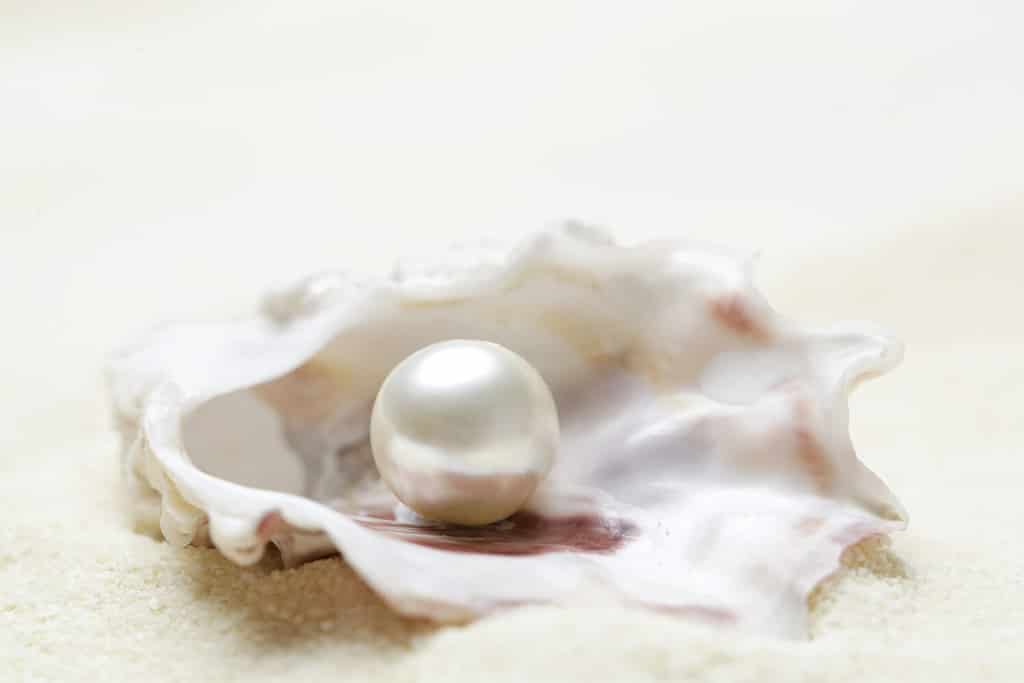
Although they aren’t necessarily as “rare” as other colors, white South Sea pearls are some of the most valuable and expensive pearls in today’s market, in part due to their impressive size and luster.
©triocean/Shutterstock.com
Although they may be the most common, there is nothing quite like the classic beauty of white pearls. For centuries, stunning white pearls have been used as the centerpiece for engagement rings and other romantic jewelry, as well as elegant necklaces and accessories for kings and queens. There are many different shades of white pearls, from neutral to milky white, cream, and ivory.
There are also many different types of white pearls, but white Akoya pearls are some of the most popular. These tiny sea treasures come in all sorts of neutral colors like white and gray, often with pretty overtones of green, pink, or silver shimmering on their surface. Akoya pearls come from small saltwater oysters and produce pearls that range in size from as tiny as 1 mm (0.04 inches) all the way up to 11 mm (0.43 inches).
On the other hand, white freshwater pearls tend to have more warm tones, with cream, silver, and rose overtones. In addition, white South Sea pearls are usually a very bright, cool white, with an impressive luster and shine. White South Sea pearls are also some of the largest white pearls you can find, with some growing up to 20 mm (0.79 inches) in diameter!
Summary of 9 Colors of Pearls (Rarest to Most Common)
| Color of Pearl | Traits | Location | Rarity | |
|---|---|---|---|---|
| 1 | Blue Pearls | Shades of pastel, light aquamarine or deep, dark blue; valuable; imperfect shape | Oceans around Australia and Japan | Most rare |
| 2 | Golden Pearls | Usually round or baroque; one of most expensive colors; shiny & bright; large | Oceans around Indonesia, the Philippines, and Australia | Very Rare |
| 3 | Lavender and Purple Pearls | Hues include pastel lilac, deep violet, and royal purple; opalescent sheen; aubergine purple and Edison pearls are very popular and expensive | Tahiti and the South Sea | Rare |
| 4 | Cherry Pearls | Reddish pink color, with a reddish pink shimmering overtone; redder ones are shining rosy-colored copper pennies | Tahiti | Rare |
| 5 | Green Pearls | Natural green ones found in both salty ocean water and fresh river water oysters; the Peacock Tahitian variety is very popular | French Polynesia | Very Rare |
| 6 | Chocolate and Brown Pearls | Natural Tahitian chocolate pearls are rich bronze, charcoal brown, chocolate, mink, or greenish brown with varied overtones and undertones | French Polynesia | Natural ones are Rare |
| 7 | Pink Pearls | Pastel pink, peachy, lavender, or rich deep rose hues; one of most popular commercial colors | China, Japan, United States | Rare; freshwater ones most common |
| 8 | Black Pearls | Tahitian pearls and Cortez pearls are naturally black; hues include dark gray, charcoal, silver, or fully black | French Polynesia | Originally very rare but more common with farms |
| 9 | White Pearls | Akoya pearls are most popular white variety; grown in fresh and salt water; hues include neutral, milky white, cream, and ivory | South Seas | Most Common |
The photo featured at the top of this post is © Praiwan Wasanruk/Shutterstock.com
Thank you for reading! Have some feedback for us? Contact the AZ Animals editorial team.






